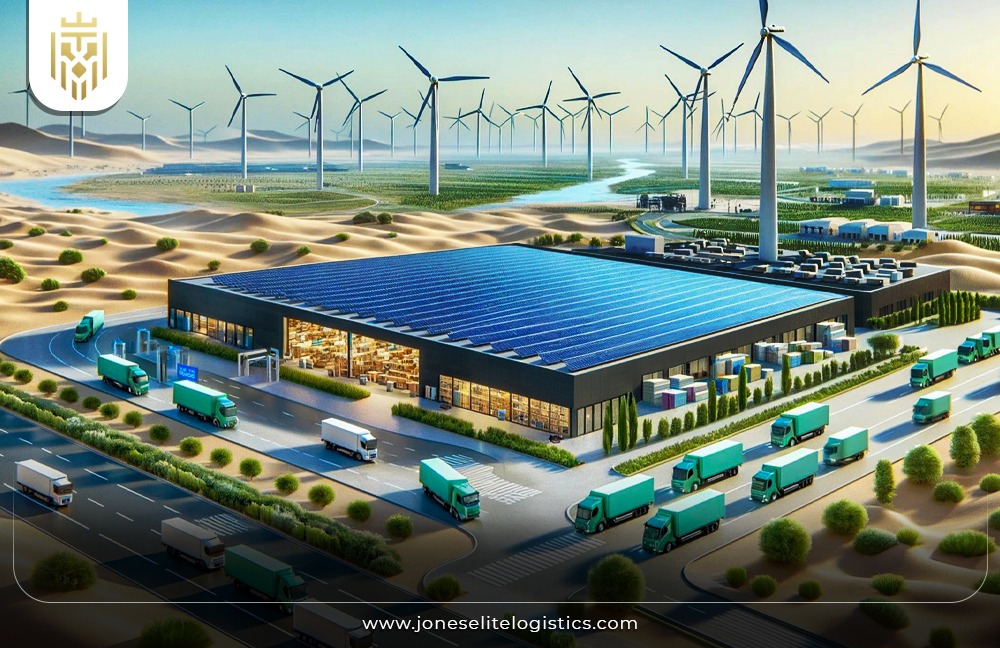What is Green Logistics and its Importance:
Green logistics is defined as the integration of sustainability principles into the analysis, planning, design, and execution of logistics and supply chain management. This consequently entails decreasing carbon emissions, improving energy efficiency, and avoiding waste in various processes. Lastly, the green benefits of logistics consist of increasing corporation environmental responsibility, following the laws and regulations established to protect the surrounding environment, and the generally positive impact of green logistics on a company’s reputation.

Objectives of Green Logistics:
Specific goals of green logistics include reduction of the overall impact of logistics on the environment, improvements to energy utilization, and encouragement of the use of renewable resources. It will help to avoid unnecessary emissions of various wastes, lessen the rates of greenhouse gas emissions, and fulfill environmental standards.
Green Logistics Principles:
Components of green logistics are concerned with minimizing the negative impact on the environment and are efficient. It consists of minimizing waste, making efficiency in the usage of assets and resources, and meeting environmental standards. These principles promote the optimal utilization of clean and renewable energy for power production, efficiency in the transport sectors, and environmentally friendly packing.
Reduce Wastage:
Minimizing wastage in the green syllabus in the context of this paper means controlling the amount of waste that is produced right from the point of production, packaging, and transportation to the final warehousing of the consignment. This can be done in terms of using environmentally friendly packing materials, coming up with better ways of packing, and improving the methods of storing these products. It enables minimized waste to meet environmental goals in addition to the fact that it enables minimized waste disposal and material usage costs.

Optimize Resource Utilization:
Efficiency in green logistics has to do with the effective use of resources whereby the implication is that fewer resources should be used. This involves reducing fuel consumption in transportation, rationalizing efficient storage systems, and putting into practice efficient stock control to name but a few. The costs for resource consumption are minimized whereas the waste drainage and carbon footprint are minimized by efficient resource utilization.
Follow Rules and Regulations:
One of the green logistics principles that need to be followed is the compliance with rules and regulations of the environment. This includes following legal requisites on emission, waste, and resource utilization at local, national, and global levels. Implementing these regulations maintains compliance with the law and prevents one from incurring penalties in the commerce of the industry whilst enhancing sustainable practices.
Reduced Carbon Emissions:
Green logistics strategically aims at achieving lower carbon emissions in the supply chain. This can be done through the provision of low-emitting vehicles and development of an efficient road network for transport, and the adoption energy energy-efficient measures in the transport depots. Cutting down carbon emissions is an effective way of addressing climate change mitigation, enhancing environmental quality, and supporting the sustainability standards as envisioned across the world.

Tips to Implement Green Logistics:
Green logistics has been defined as the practicable implementation of measures whose aim is to decrease the adverse effects on the environment without causing negative changes in productivity or cost. We shall be going through some of these tips.
Route Optimization:
Route optimization is a process of planning various routes by employing sophisticated route planning algorithms to find the most suitable ones for deliveries. Reduction of distances traveled and avoiding heavily congested parts of the town would help companies reduce fuel use. This not only reduces operation expenses but also decreases previous delivery time and improves customer satisfaction in the view of being environmentally friendly.

Efficient Transportation:
Efficient transportation also involves the use of vehicles that are fuel efficient or those that are fitted with flash drives rather than fuel such as electric or even hybrid vehicles. It is known that, in comparison with traditional diesel or gasoline vehicles, these vehicles emit fewer pollutants. Also, further, improved driving standards and modern technologies for fleets can help companies minimize their share of CO2 emissions and other operational expenses
Efficient Warehouse Management Systems:
Advanced warehouse management systems (WMS) employ sophisticated technology that aims at efficiently managing the storage and retrieval of products in the warehouse as well as managing the inventories. Such systems can prove to be useful in the reduction of energy use, lessening of wastage, and enhancement of general system performance.

Regular Maintenance of Vehicles:
Daily checks and services mean vehicles are tuned for optimal performance hence energy efficient and fewer emissions. Simple periodic health checks can tell things like low tire pressure or faulty fuel-efficient engines that result in high fuel consumption rates.
Load Optimization:
Although combined with just-in-time for production, load optimization aims at optimizing the loading space in the transport vehicles to eliminate unnecessary trips. Another strategy that can help cut operational costs is to ensure that the trailers picked are full, and where possible the consolidation of shipments can help avoid empty trips. It also helps in reduced usage of fuel, little or no emissions and hence cutting on the general expenses of transport.
Improve Stock Measurement:
Optimizing the measurement of stocks enhances the ability to identify the real levels of stock hold, thus avoiding instances of holding excessive or insufficient stocks. Modern technologies in inventory control can be a valuable asset since the information derived can be processed in real-time to make accurate predictions for future demand and the replacement of inventory as and when it is needed.
Roof Top Solar Panels:
The use of solar panels for roofing in the distribution centers helps in using natural non-depleting energy rather than using depleting sources such as fossil fuels. Loading of warehouse with sunlight is a very effective way of providing electricity for lighting, heating, cooling, and other operations since the panels can produce good amounts of electricity.

Green Logistic Management and Practices:
Green logistics management refers to several strategies targeting attempting to make actual logistics procedures as sustainable as possible. Some of these strategies include:
Eco-friendly Packaging:
Environmental friendly packaging entails the use of packing material that is reusable, recyclable, and biodegradable to minimize waste and pollute the environment. There are available packaging designs that less material can be used than others, and the available space could also be managed properly.
Eco-friendly Transportation:
Sustainable transport describes transportation systems, vehicles, technologies, and operational approaches that utilize alternative fuel, electric power, or enhanced fuel economy. This minimizes greenhouse emissions and encourages sustainable supply chain management. Firms can also incorporate the use of multidimensional transport that incorporates rail, road as well as sea transport to minimize the distance covered and hence lessen carbon emissions points.

Renewable Resources for Manufacturing:
The practice also reduces environmental pollution and the consumption of limited resources in the production of equipment and materials. Sustainable resources like bamboo, hemp, or recycled materials can substitute traditional unprocessed materials.
Usage of Recycled Materials:
Having recycled material within the products and their packaging improves the management of waste, and the conservation of resources, and it minimizes the effects that manufacturing may have on the environment. This practice is prefaced to the circular economy because it helps avoid the disposal of products
Implement Reverse Logistics:
Conversely, reverse logistics covers the procedures of recovering, recon-monetizing, or reselling products and other usable materials in an organization. It involves taking products by customers back to the producers or sellers for reselling, recycling, or disposal.

Choose GreenSupply Chain Partners:
This is a crucial aspect of a green supply chain since it is the practice of selecting the green supply chain partners that are involved throughout the logistics processes. It is already allied with environmental initiatives, for example, using standards like renewable energy, waste minimization, as well as emissions. Working with such partners ensures greater support to the supply chain and the corporate responsibility for sustainability.
Leverage AI for Deliveries:
Applying AI in deliveries makes the best out of routes increases demand or sales forecast and makes delivery systems effective. Even traffic patterns of different cities, weather conditions, and delivery timelines can be fed to the AI algorithms which can then determine the most efficient routes to be taken thus minimizing fuel utilization and pollution.
Advantages of Green Logistics:
Some benefits of green logistics are that it is inexpensive in the long-term and has environmental impacts and it also has positive impacts on the brand image of the firm. We shall go through them in detail:
Reduced Transport Costs:
Eco-friendly transportation means cutting costs through better route planning, fuel economy, and consolidation. Such practices reduce on amount of fuel used and the frequency of maintaining the engine thus proving to be economical in the long run.
Environmental Benefits:
Social impacts of green logistics include reduced emission of greenhouse gases and other pollutants into the atmosphere, air and water quality improvement, and the general conservation of the natural environment. The benefits of sustainability are listed as returning the ecosystem to a healthier state to fight climate change.
Lower Packaging Costs:
Several benefits arise from this – costs are cut when using a small amount of resources for packaging and avoiding wastage. Reusable and recyclable packaging ultimately contributes to maximum cost savings for the long term and also reduces the impact on the natural surroundings.
Increase Customer Awareness:
Caring for the environment and the feasibility of sustainable solutions are the main aspects improved thanks to green logistics, with a rise in customer awareness. Sustainability makes consumers more inclined to purchase products from firms that consider environmental concerns resulting in improved firm brand image.

Strengthen Brand Reputation:
Logistics integration improves its environmental sustainability and also helps to enhance its brand image by exhibiting societal responsibility. Policies that are environmentally sound are adopted by organizations that aim to increase their popularity among environmentally conscious citizens and investors, thereby increasing their attractiveness to the competition and market in general.
Operational Efficiency Improvement:
Green logistics makes operations effective through enhanced resource-friendly use, reduced waste, and efficient logistical flows. Supply chain management has benefits such as faster delivery and reduced direct materials, service, and operating costs while increasing service quality.

Challenges of Green Logistics:
Even though green logistics works to bring numerous advantages, this concept has various problems, for example, high initial outlay, the absence of appropriate logistics infrastructure, the shortage of environmentally friendly materials, the absence of cooperation, and legal constraints.
Initial investment:
The costs associated with engaging in sustainable logistics can sometimes be significant in the beginning. large capital investments are required to switch to energy-efficient automobiles, instill superior technologies, and modernize the buildings in which they are located.
Lack of Infrastructure:
Another challenge faced is the incongruous development and infrastructure, and accessibility to services that are sustainable like charging stations for electric cars or a recycling center. Availability of infrastructure is one of the major challenges that explain why green logistics has not spread across the regions.
Limited Availability of Sustainable Materials:
Resources for sustainable materials are scarce hence they may limit the utilization of green logistics. It might even be difficult to source environmentally friendly packaging material and renewable resources and normally may be expensive.
Lack of Collaboration:
Environmental initiatives in the supply chain are restricted or slow because of a lack of cooperation between the links of the relevant chain. Sustainability implementation is a cross-organizational effort that needs commitment across all stakeholders to be effective.
Regulatory Barriers:
Another challenge, that hinders the green agenda in the supply chain, is the lack of standardization of environmental regulations and high compliance costs. The legal regulation of these industries is complex, which means that compliance with them takes time, money, and experience.
Green Logistics – Future of Business:
Sustainable logistics practices are gradually emerging as critical to attaining a competitive edge, satisfying the customers as well as organization sustainability. Green logistics is still a developing field that benefits from technological enhancements and better infrastructure to meet the global demand for sustainable supply chains.
FAQs
1) What is Green Logistics?
Green logistics is the process of incorporating sustainable strategies in the supply chain management of products to lessen the impact on the environment by adopting diplomatic strategies in the use of carbon, optimal use of resources, and elimination of wastage.
2) What are the benefits of green logistics?
Advantages of green logistics include transportation, packaging, environmental, image and overall awareness, and organizational longevity.
3) What are the challenges of green logistics?
Barriers to green logistics are mainly, a high risk of investments, inadequate access to structures, low availability of environmentally friendly commodities, poor cooperation between partners, and regulation.
4) What are the objectives of Green Logistics?
Predefined goals consist of reducing the ecological impact, improving the energy demand, using renewable energy, reducing surplus, emissions, and fines, and improving the sustainability of supply chains.







